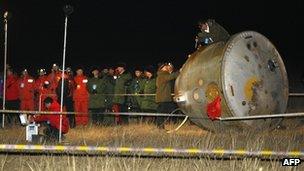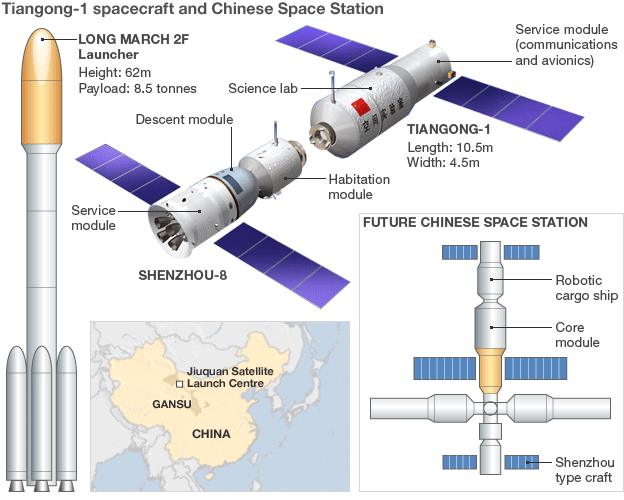China white paper sets out five-year space plan
- Published

The unmanned Shenzhou-8 returned to Earth, after completing two space dockings last month.
China has released a white paper setting out its space plans for the next five years.
China ''will push forward human spaceflight projects and make new technological breakthroughs'', the report said.
It plans to develop next-generation rockets, new types of satellites and carry out deep-space exploration.
In the long term, China is working towards building a space station and putting a person on the moon.
<link> <caption>The white paper</caption> <altText>The white paper</altText> <url href="http://www.chinadaily.com.cn/cndy/2011-12/30/content_14354558.htm" platform="highweb"/> </link> also summarised China's space activities since 2006 and spelt out policies for international co-operation, in a move that appeared aimed at allaying concern over its space ambitions.
''China will work together with the international community to maintain a peaceful and clean outer space and endeavour to make new contributions to the lofty cause of promoting world peace and development,'' said the report.
It lists collaborations with countries such as Russia, Brazil, France and Britain. China will also ''continue to make dialogue regarding the space field'' with the US, following a NASA delegation visit in October.
China views its space programme as a key part of its national development and international growth.
According to the white paper, the Shenzhou-9 and Shenzhou-10 spaceships will be launched to dock with the Tiangong-1 space lab module.
Tiangong-1, which means ''heavenly palace'', was launched aboard a Long March 2F rocket in September. It is a prototype module for China's future space station.
Last month the Shenzhou-8 spent just under 17 days in orbit - the longest Shenzhou mission to date - and rendezvoused with the space lab.
Officials have indicated that at least one of the two next Shenzhou missions would be manned and that 2012 might even see the country's first female astronaut.
The white paper also said China would improve its Long March launch vehicles, building next-generation rockets that used ''non-toxic and pollutant-free propellant''. It plans to upgrade launch sites and finish a new launch base in Hainan.
It will also continue building its Beidou satellite navigation system, with aims to cover the Asia-Pacific region by the end of 2012 and complete global coverage by 2020.
China will also launch orbiters to survey the moon, land on it and obtain samples that can be studied.
Ultimately, it wants to put a person on the moon. In the next five years, the report said, China will ''conduct studies on the preliminary plan for a human lunar landing''.

- Published17 November 2011
- Published2 November 2011
- Published31 October 2011
- Published30 September 2011
- Published30 September 2011
- Published29 September 2011
- Published29 September 2011
- Published29 September 2011
- Published1 October 2010